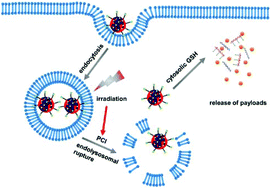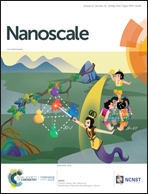A light-facilitated drug delivery system from a pseudo-protein/hyaluronic acid nanocomplex with improved anti-tumor effects†
Abstract
Reduction-sensitive nanomedicine is a promising strategy to achieve controlled release of payloads in response to intracellular reductive milieu. However, endolysosomal sequestration of internalized carriers and insufficient redox potential in endolysosomes may delay the release of payloads and impact their therapeutic efficacy. Photochemical internalization (PCI), which takes advantage of light-induced endolysosomal rupture, is an effective technique for endosomal escape and cytosolic release of cargos. In this study, a biodegradable and reduction-sensitive nanocomplex was developed from arginine based poly(ester amide)s and hyaluronic acid (HA), and the PCI-photosensitizer AlPcS2a was conjugated to the surface of the nanocomplex (ArgPEA-ss-HA(AP)). This nanocomplex was used for the co-delivery of both PCI-photosensitizers and therapeutic agents to eliminate the biodistribution discrepancy resulting from the separated administration of free therapeutics. The PCI effect of the ArgPEA-ss-HA(AP) nanocomplex was validated in both monolayers and 3D spheroid models of MDA-MB-231 breast cancer cells. Synergism was detected between the PCI effect and doxorubicin-loaded nanocomplex in the inhibition of MDA-MB-231 cells. In addition, the ArgPEA-ss-HA(AP) nanocomplex also provided enhanced intratumoral penetration in 3D spheroids compared to free AlPcS2a. The in vivo results suggested that the conjugation of AlPCs2a in the nanocomplex enabled the consistent and preferential accumulation of both doxorubicin and AlPcS2a in tumor sites. A light-enhanced anti-tumor effect was observed for the doxorubicin-loaded nanocomplex at well-tolerable dosage. The ArgPEA-ss-HA(AP) nanocomplex, as a reduction-responsive delivery vehicle, can hold great potential to achieve spatio-temporally controllable anti-tumor effects.



 Please wait while we load your content...
Please wait while we load your content...